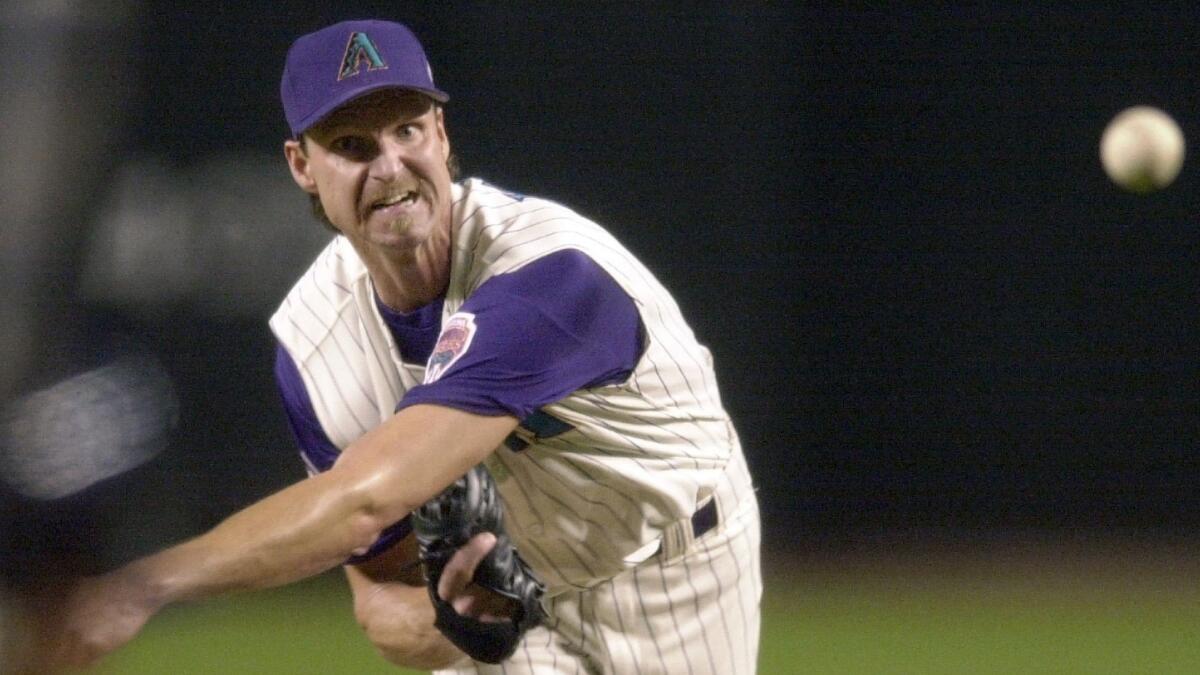Randy Johnson went from ‘Wild Thing’ to ‘Big Unit’ before Hall of Fame

The biggest numbers Randy Johnson posted early in his 22-year major league career were not the ones that made him a first-ballot inductee into Baseball’s Hall of Fame.
Johnson, a gangly 6-foot-10 left-hander who was a second-round pick of the Montreal Expos out of USC in 1985, led the American League in walks for three straight seasons, racking up 120 while with the Seattle Mariners in 1990, 152 in 1991 and 144 in 1992.
“I don’t think people quite understand how difficult it is to be 6-foot-10 and throwing a ball 60 feet, 6 inches,” Johnson said Tuesday during a conference call after the voting was announced. “In order to do that, you have to be consistent with your release point, your arm slot and where you’re landing. For someone who is 6-1, 6-2, he has less body to keep under control, so it’s a lot easier. For me, it was difficult because I was so tall.”
Johnson eventually refined his mechanics -- “It wasn’t a one-year kind of thing, it was gradual,” he said -- to become one of the best pitchers in baseball history. Using a nasty fastball-slider combination, he had a record of 303-166 with a 3.29 earned-run average and 4,875 strikeouts for six teams from 1988 to 2009.
He was the leading Hall of Fame vote getter, named on 534 of the 549 ballots. Johnson won five Cy Young Awards, including four straight with Arizona from 1999 to 2002, and helped the Diamondbacks win a memorable 2001 World Series over the New York Yankees, throwing seven innings to win Game 6 and 1 1/3 hitless innings of relief to win Game 7 the following night.
Johnson had six 300-strikeout seasons, tying strikeout king Nolan Ryan for the most in baseball. No other pitcher had more than three such seasons. And from 1994 on, Johnson had only one season in which he walked more than 77 batters.
“Obviously, my height was to my advantage, but only when I was able to harness my ability,” Johnson said. “Being 6-10, all arms and legs, there weren’t many power pitchers before me like that. I didn’t have a blueprint to work with. But over time, with hard work, I became more consistent with my mechanics.”
Asked what achievements he was most proud of, Johnson listed that 2001 championship and the tenacity he showed in overcoming three knee surgeries and three back surgeries.
Johnson also helped save baseball in Seattle, starring for a Mariners club that overcame a 13-game early August deficit to beat the Angels in a one-game playoff for the American League West title in 1995. He also went 10-1 with a 1.28 ERA in 11 starts after a late-July trade to lead Houston to the 1998 playoffs.
But Johnson, nicknamed “The Big Unit,” chuckled when he recalled two of the incidents he is most known for -- killing a dove with a pitch that hit the low-flying bird during a 2001 spring-training game and his comical whiff of John Kruk in the 1993 All-Star Game at Baltimore’s Camden Yards.
Johnson’s first-pitch fastball sailed high over the head of the left-handed-hitting Kruk, who ducked out of the box, smiled and tapped his chest several times, as if he was just glad to have survived. Kruk then bailed out of the box while swinging meekly at the next three pitches.
“It was humid, and the first pitch got away,” Johnson said. “The outcome was great, and there was probably no better person to have at the plate than Kruk with his sense of humor.”
Johnson also took time during his conference call to stump for former Mariners teammate Edgar Martinez, who hit .312 with 309 homers during a distinguished 18-year career but was named on only 27% of the ballots this year, far short of the 75% required for induction.
“Hands down, he was the best pure hitter that I’ve ever seen,” Johnson said. “I hope his time comes soon, when he gets a phone call stating he’s a Hall of Fame player, because he is.”
Twitter: @MikeDiGiovanna
More to Read
Go beyond the scoreboard
Get the latest on L.A.'s teams in the daily Sports Report newsletter.
You may occasionally receive promotional content from the Los Angeles Times.











